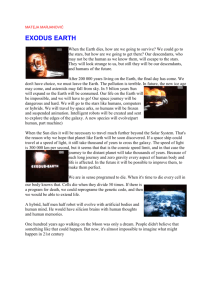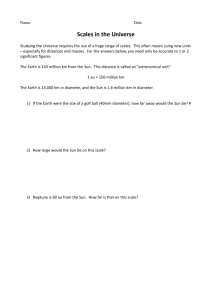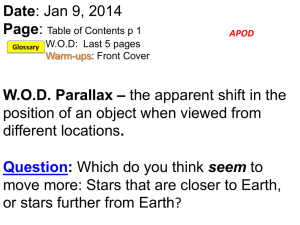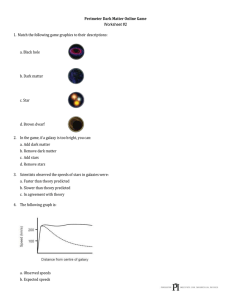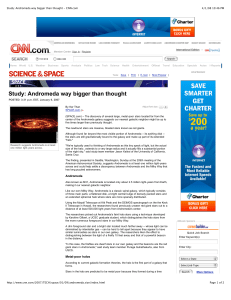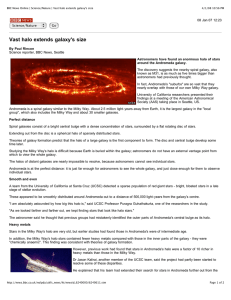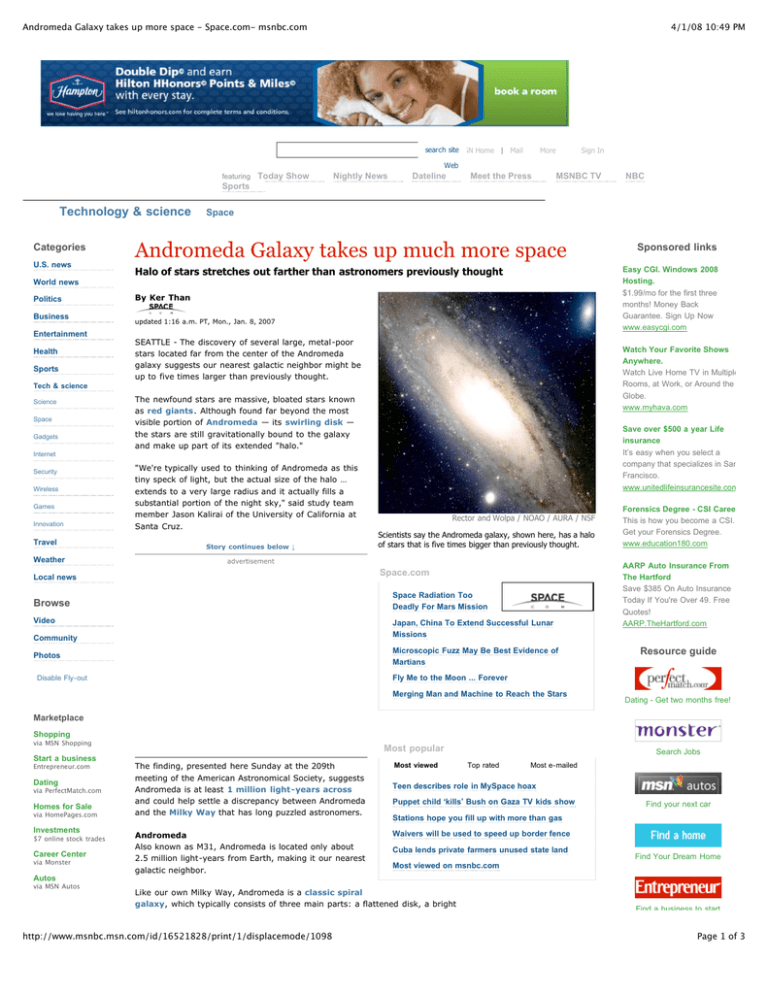
Andromeda Galaxy takes up more space - Space.com- msnbc.com
4/1/08 10:49 PM
search siteMSN Home | Mail
More
Sign In
Web
featuring
Today Show
Nightly News
Dateline
Meet the Press
MSNBC TV
NBC
Sports
Technology & science
Categories
U.S. news
Space
Andromeda Galaxy takes up much more space
Halo of stars stretches out farther than astronomers previously thought
Easy CGI. Windows 2008
Hosting.
$1.99/mo for the first three
months! Money Back
Guarantee. Sign Up Now
www.easycgi.com
World news
Politics
Business
Entertainment
Health
Sports
By Ker Than
updated 1:16 a.m. PT, Mon., Jan. 8, 2007
SEATTLE - The discovery of several large, metal-poor
stars located far from the center of the Andromeda
galaxy suggests our nearest galactic neighbor might be
up to five times larger than previously thought.
Watch Your Favorite Shows
Anywhere.
Watch Live Home TV in Multiple
Rooms, at Work, or Around the
Globe.
www.myhava.com
Tech & science
Science
Space
Gadgets
The newfound stars are massive, bloated stars known
as red giants. Although found far beyond the most
visible portion of Andromeda — its swirling disk —
the stars are still gravitationally bound to the galaxy
and make up part of its extended "halo."
Save over $500 a year Life
insurance
It’s easy when you select a
company that specializes in San
Francisco.
www.unitedlifeinsurancesite.com
Internet
Security
Wireless
Games
Innovation
Travel
Weather
"We're typically used to thinking of Andromeda as this
tiny speck of light, but the actual size of the halo …
extends to a very large radius and it actually fills a
substantial portion of the night sky," said study team
member Jason Kalirai of the University of California at
Santa Cruz.
Story continues below ↓
Rector and Wolpa / NOAO / AURA / NSF
Scientists say the Andromeda galaxy, shown here, has a halo
of stars that is five times bigger than previously thought.
advertisement
Space.com
Local news
Space Radiation Too
Deadly For Mars Mission
Browse
Video
Japan, China To Extend Successful Lunar
Missions
Community
Microscopic Fuzz May Be Best Evidence of
Martians
Photos
Sponsored links
Forensics Degree - CSI Career
This is how you become a CSI.
Get your Forensics Degree.
www.education180.com
AARP Auto Insurance From
The Hartford
Save $385 On Auto Insurance
Today If You're Over 49. Free
Quotes!
AARP.TheHartford.com
Resource guide
Fly Me to the Moon ... Forever
Disable Fly-out
Merging Man and Machine to Reach the Stars
Dating - Get two months free!
Marketplace
Shopping
via MSN Shopping
Start a business
Entrepreneur.com
Dating
via PerfectMatch.com
Homes for Sale
via HomePages.com
Investments
$7 online stock trades
Career Center
via Monster
Autos
via MSN Autos
Most popular
The finding, presented here Sunday at the 209th
meeting of the American Astronomical Society, suggests
Andromeda is at least 1 million light-years across
and could help settle a discrepancy between Andromeda
and the Milky Way that has long puzzled astronomers.
Andromeda
Also known as M31, Andromeda is located only about
2.5 million light-years from Earth, making it our nearest
galactic neighbor.
Most viewed
Search Jobs
Top rated
Teen describes role in MySpace hoax
Puppet child ‘kills’ Bush on Gaza TV kids show
Find your next car
Stations hope you fill up with more than gas
Waivers will be used to speed up border fence
Cuba lends private farmers unused state land
Find Your Dream Home
Most viewed on msnbc.com
Like our own Milky Way, Andromeda is a classic spiral
galaxy, which typically consists of three main parts: a flattened disk, a bright
central bulge of densely packed stars and an extended spherical halo where stars
http://www.msnbc.msn.com/id/16521828/print/1/displacemode/1098
Most e-mailed
Find a business to start
Page 1 of 3
Andromeda Galaxy takes up more space - Space.com- msnbc.com
4/1/08 10:49 PM
central bulge of densely packed stars and an extended spherical halo where stars
are more sparsely distributed.
Using the Mayall
Telescope at Kitt Peak and
the DEIMOS spectrograph
on the the Keck II
Telescope in Hawaii, the
researchers found
previously unseen red
giant stars out to a
distance of at least
500,000 light-years from
Andromeda's center.
The researchers picked
out Andromeda's faint
halo stars using a
technique developed by
Karoline Gilbert, a UCSC
graduate student, which
distinguishes the halo
stars from the more
numerous foreground
stars in our Milky Way.
Slide show
Find a business to start
$7 trades, no-fee IRAs
Launch
Space Shots
See distant moons, a space capsule, the southern
polar region of Mars and other out-of-this-world
highlights in the latest installment of "Space Shots."
A dim foreground star and a bright star located much farther away — whose light
can be diminished by interstellar gas — can be hard to tell apart because they
appear to have similar luminosities as stars in our own galaxy. The researchers
liken the effect to distinguishing between the light of a firefly 10 feet away and
that of a powerful beacon in the distance.
"In this case, the fireflies are dwarf stars in our own galaxy and the beacons are
the red giant stars in Andromeda," said study team member Puraga
Guhathakurta, also from UCSC.
Metal-poor halos
According to current galactic formation theories, the halo is the first part of a
galaxy that forms. Stars in the halo are predicted to be metal-poor because they
formed during a time when the universe had much less heavy metal content than
it does now. Heavy metals are created as stars evolve and then spewed out into
interstellar space when ancient stars either explode as supernovas or shed their
outer layers to become white dwarfs.
"The first stars are expected to be chemically deficient, and as these other
components such as the disk of the galaxy form later, it is contaminated by the
products of those first stars, so those stars are more metal rich," Kalirai said.
However, instead of being metal-poor, previous studies have found that
Andromeda's halo stars were actually 10 times richer in metals than halo stars in
our galaxy. This finding puzzled astronomers because both Andromeda and the
Milky Way should have similar formation histories.
The new findings could solve this discrepancy because the red giant stars are
anemic, as is expected from galaxy formation theories and what is known about
the Milky Way.
"If you plot the metalicity as a function of radius, you see a very nice trend where
the inner parts of the galaxy are metal rich, and the outer parts of the galaxy are
dominated by stars that are metal-poor," Kalirai said.
"We now believe that previous groups have been mistakenly identifying the outer
parts of the Andromeda bulge as its halo," Guhathakurta said.
Paul Hodge, an expert on the Andromeda galaxy from Washington University who
was not involved in the study, said the new finding paints a very different picture
of our galactic neighbor than was available only a few years ago.
"It's a new galaxy," Hodge said. "The outer parts of this galaxy are finally being
revealed and its turning out to be much more interesting and beautiful than when
could have imagined."
© 2007 Space.com. All rights reserved. More from Space.com.
http://www.msnbc.msn.com/id/16521828/print/1/displacemode/1098
Page 2 of 3
Andromeda Galaxy takes up more space - Space.com- msnbc.com
Rate this story
Low
4/1/08 10:49 PM
High
Current rating: 4.5 by 94 users
•
Print this
View Top Rated stories
Email this
IM this
MORE FROM SPACE
Space Section Front
Smallest, lightest black hole identified
Solar tsunamis move lightning fast
Shuttle shutdown may kill 8,000 jobs
Astronomers peer back at early universe
Magnificent vacations on Mars
Will Japan's space program take off?
NASA's air-safety project criticized
Cosmic Log: Under the neutron microscope
See the cosmos on your computer
Test your science and space smarts
Space Section Front
Add Space headlines to your news reader:
More RSS feeds from MSNBC.com
Top msnbc.com stories
NBC News highlights
NYT: Primary tests Dems' low-key chief
Publisher sees life after 'Harry Potter'
Land reforms could reshape Cuba
Mr. Mom? Tips for stay-at-home dads
Fuel a loss leader for gas stations
America's first ‘test tube’ twins turn 25
ACLU: Military using FBI to skirt the law
For Condi Rice, no excuses not to exercise
Scientist: CDC ignored trailer warnings
Wal-Mart disabled ex-worker won't pay
SPONSORED LINKS
Forensics Degree - CSI Career
This is how you become a CSI. Get your Forensics Degree.
www.education180.com
Get listed here
Earn Your Degree Online at Kaplan U
A College Degree Can Be Yours. 100% Online, Fully Accredited
www.kaplan.edu
Paralegal Degree Online
Become a Paralegal. Earn your Degree completely online.
www.careerdegreesource.com
AARP Auto Insurance From The Hartford
Save $385 On Auto Insurance Today If You're Over 49. Free Quotes!
AARP.TheHartford.com
Invest in your Future: Be Your Own Boss
Work from Home Processing Rebates – Start Today!
makemyincomeathome.com
Featuring
Today
Categories
Top stories
Nightly News
Entertainment
About
© 2008 Microsoft
MSN Privacy
Legal
About us
Dateline
Local news
Health
Contact
U.S.
Meet the Press
MSNBC TV
World
Business
Politics
Tech & science
Site map
Jobs
Travel
http://www.msnbc.msn.com/id/16521828/print/1/displacemode/1098
Alerts via
IM
Weather
Terms & conditions
Advertise
Newsweek
Sports
Mobile
headlines
msnbc.com is a division of the
Page 3 of 3


